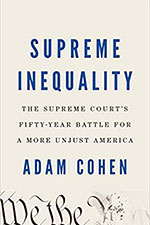 VERDICT: Touchdown!
VERDICT: Touchdown!
Supreme Inequality: The Supreme Court’s Fifty-Year Battle for A More Unjust America
By Adam Cohen (New York, NY: Penguin Press, 2020). 415 pgs. $30. Order, www.penguinrandomhouse.com.
Reviewed by Dianne Post
Adam Cohen is an attorney and a journalist, and I had read one of his previous books,Imbeciles: The Supreme Court, American Eugenics, and the Sterilization of Carrie Buck. The new book is as good as the previous one. He outlines the history of U.S. Supreme Court jurisprudence from 1953 when Earl Warren was sworn in as Chief Justice to now. Cohen describes what happened after Warren did not turn out as Eisenhower had hoped: Nixon exerted pressure to change the court by retirement and campaigns against Abe Fortas so he would resign and the court could be remade.
In the 1930s, the Supreme Court was decidedly pro-business until FDR threatened to pack the Court so he would get a majority to support his New Deal legislation. In the conclusion, the author says today’s legal architects don’t want to go back to the 1960s, they want to go back to the 1930s when businesses had entirely free rein – and brought us the Great Depression.
Cohen focuses on key issues that matter to a vast number of Americans. He shows how the Supreme Court turned from protecting low-income people to demonizing them and how the promise of equal education under Brown v. Board of Education has been steadily undermined, to the point that today schools in the United States are more segregated than they were in the 1950s.
I was particularly interested in the chapter about campaign finance, starting with the Buckley v. Valeo opinion and ending with Citizens United. I was in law school when Buckley came out and wrote a paper in my constitutional law class about what a horrible decision it was and that it would lead to widespread corruption and the destruction of democracy. My professor vehemently disagreed, and we had several heated arguments. I think he gave me a B. I should go back and ask him to retroactively correct that to an A as everything I prophesized has occurred.
Want to Review a Book?
Please request a book and writing guidelines from Wisconsin Lawyer managing editor Karlé Lester, at klester@wisbar.org or (608) 250-6127. Reviewers may keep the book reviewed. Reviews of about 500 words are due within 45 days of receiving the book. Reviews are published, space permitting, in the order received and may be edited for length and clarity.
The destruction of voting rights for targeted minorities, with Bush v. Gore and Shelby County being prime examples, illustrates another value that apparently the Supreme Court does not hold in high esteem. Chief Justice Warren said that what matters most in election law cases is “fair representation in our governmental systems.” The current Supreme Court recently admitted that though gerrymandering violates voting rights, the Court just can’t do anything about it.
Attacks on workers and unions have come from every direction, including fee checkoffs, “right to work” laws, NLRB decisions, wage theft, “tort reform” to shield corporations from the harm done to workers, punitive-damages reductions, and on and on. The chapter on corporations examines cutting the amount of punitive damages no matter how bad the conduct of the corporation, limiting class actions, mandating arbitration, allowing the destruction of the environment, and granting corporations constitutional rights that people don’t even have (the late Justice Scalia made clear that the 14th Amendment does not cover women though it does cover corporations.)
In criminal justice, the Court has hollowed out the momentous rulings that gave accused individuals some rights: Miranda, Gideon, and Mapp. Because of the Court’s refusal to require payment for defense attorneys for indigent defendants, the rulings don’t mean much in real life. The destruction of Batson has been so thorough that state courts are having to pass their own rules to end jury bias (for example, Washington and Arizona). The U.S. Supreme Court found nothing wrong with keeping an Army veteran with three children in prison for life for shoplifting $153.54 worth of children’s videos but found it oppressive for McDonald’s Corp. to pay $9 million in punitive damages for harming a customer with a physical disability, despite the company having $50 billion in annual revenue.
The author covers every aspect of the law and policy that the Supreme Court sets. His careful analysis leaves one to wonder about the impartiality of the third leg of our balance of powers and gives pause about the strategy of bringing cases to this Supreme Court.
Dianne Post, U.W. 1979, practiced family law for 18 years and then began international human rights work for the next 15.
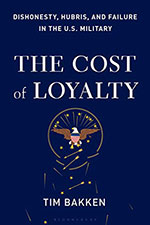 VERDICT: It’s a Keeper
VERDICT: It’s a Keeper
The Cost of Loyalty: Dishonesty, Hubris, and Failure in the U.S. Military
By Tim Bakken (New York, NY: Bloomsbury Publishing, 2020). 368 pgs. $19.60 Order, www.bloomsbury.com.
Reviewed by Scott Brown
In The Cost of Loyalty, Tim Bakken offers an intriguing perspective on the U.S. Armed Forces and how the culture at West Point and the other service academies informs commissioned officers’ approaches to leadership and thereby has affected the course of American history. Bakken boldly steps on the proverbial third rail of discourse in the United States and offers a scathing critique on the one institution that has consistently enjoyed the trust and esteem of most Americans. His book is remarkably well researched, and he meticulously argues that the failure for the past 75 years or more to properly educate future U.S. military leaders has led to the repeated failure of the armed forces to achieve success in foreign conflicts. Bakken’s position is that the cost of loyalty is the sacrifice of almost every other value, including honesty, humility, and integrity.
The reader walks through the U.S. military’s involvement in various conflicts since the conclusion of World War II and is provided with many accounts of blind loyalty, hubris, sycophantry, and motivated reasoning among its leaders. In conjunction with his critique of military leaders’ character flaws, Bakken provides examples of how education and training at West Point cultivated these traits and argues that the result has been disastrous foreign policy.
For example, he details how the Gulf of Tonkin incident (1964) catalyzed the Vietnam War and how it was later revealed that the incident actually never happened. Decades later, the Iraq War was sold to the American public based on information that many people later called into question. In both instances, Bakken argues, officers’ desire to tell their superiors what they thought the superiors wanted to hear rather than providing honest, analytical assessments of the intelligence led to bad decisions when the stakes could not be higher.
Bakken claims that West Point and the other service academies reward students for duplicating and parroting the thoughts and views of their superiors as well as following tradition. In contrast, independent thinking and challenging authority are discouraged. He hypothesizes that this results in the repetition of the same errors by generations of military leadership, the inability to think creatively, and the stunting of U.S. foreign policy.
The Cost of Loyalty sometimes presents its severe critique of the U.S. Armed Forces with the erudition one would expect from a professor of law. At other times, it reads like a scandalous unauthorized biography. Bakken’s writing is clear and persuasive, and he provides detailed accounts of what he perceives as the failings of the U.S. military and the schools that mold its leaders. If you are interested in a heterodox analysis of the U.S. military’s performance, and a critique of how West Point is educating and training future military leaders, you should definitely check out this book.
Scott Brown, Rutgers 2005, is an attorney at the Milwaukee County Office of Corporation Counsel.
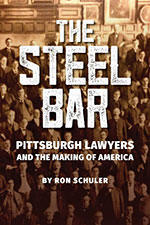 VERDICT: It’s a Keeper
VERDICT: It’s a Keeper
The Steel Bar: Pittsburgh Lawyers and the Making of America
By Ron Schuler (Pittsburgh, PA: Marquez Press, 2019). 660 pgs. $36 paperback. Order, www.amazon.com.
Reviewed by Joey Roeth
The Steel Bar: Pittsburgh Lawyers and the Making of America is a comprehensive history of the legal profession in Pittsburgh, from the colonial days of lawyers riding circuit on horseback to the rise of specialized law firms in the modern era. Author Ron Schuler, a managing partner for the Pittsburgh office of a regional law firm, shines a spotlight on the past members of his local bar association who shaped significant events in American history.
Because the author condenses more than 200 years of history into one substantial work, the book can be a daunting read. The book primarily recounts how a well-organized legal community became established outside of the East Coast metropolitan centers and managed to produce some of the country’s most influential lawyers. The book contains pictures of many of the lawyers who are featured, as well as extensive endnotes and bibliographic references. The author presents the material in a chronological fashion. He also conveniently divides the material into small subsections and provides a description of these subsections in the table of contents. This format makes it easier for readers to skip around the material.
The author includes a wide diversity of topics to maintain interest. For example, incidents such as the aggressive poaching of rival baseball players by the Pittsburgh Pirates and the mysterious death of a district attorney in the 1970s provide interesting contrast to the weightier topics in the book.
The best sections of the book highlight the unique circumstances in Pittsburgh that forged the legal community. First, the book opens with Pittsburgh as an 18th-century frontier town at the epicenter of the Whiskey Rebellion. The author effectively describes how lawyers were involved in all sides of the crisis, from David Bradford, who infamously led the armed insurrection, to Hugh Henry Brackenridge, who nearly lost his life trying to mediate.
Later, the book really shines in its exploration of the Gilded Age. The rise of Pittsburgh as an industrial center in the 19th century saw the development of a new, commerce-oriented profession in the city. Pittsburgh lawyers, such as Thomas Mellon, worked alongside industrial tycoons to define the rules and governance of the corporation, to raise capital, protect investors, and reduce governmental interference. Similarly, lawyers for the nascent labor movement had to define the role and rights of workers in the absence of any statutory or common-law guidance. By 1900, many of these business and labor lawyers would hold influential positions in all three branches of the federal government.
As such, The Steel Bar provides a unique history of the legal profession that focuses on lawyers practicing outside the bench or lecture hall.
Joey Roeth, Marquette 2008, is legal counsel at the Wisconsin Education Association Council in Madison.
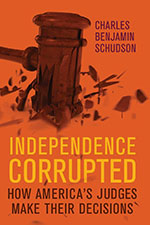 VERDICT: Touchdown!
VERDICT: Touchdown!
Independence Corrupted: How America’s Judges Make Their Decisions
By Hon. Charles B. Schudson (Madison, WI: Univ. of Wisconsin Press, 2018). 272 pages. $35.07. Order, www.amazon.com.
Reviewed by Mary L. Richards
Brutally honest, intensely revealing, and riveting. In Independence Corrupted: How America’s Judges Make Their Decisions, the Hon. Charles Schudson takes the reader on a fascinating, quick-paced journey behind the secrecy and mystery of how justice is handed out in a court system where 90 percent of our nation’s judiciary is elected. Schudson uses the truism of “who’s the judge?” as the analytical jumping-off point to show the reader the battle of alleged objectivity, subjectivity, politics, human imperfection, and compassion in this scholarly study of judicial behavior and decision-making.
A masterful storyteller, Schudson first sets the stage by providing the historical backdrop of “judging,” mixed with recent U.S. Supreme Court decisions that rapidly sped up the blunt conflict between confidentiality, impartiality, and judicial transparency. He then guides the reader through eight specific trial court and appellate decisions involving a range of topics, such as anti-abortion protesters, sexual predators, death, insurance companies and corporate interests, white supremacists, and so on. Schudson details these specific cases from his time as both a circuit court judge and a court of appeals judge to show the effects of individual versus collaborative decision-making in which law, human dynamics, and compassion play out. Finally, he examines judicial campaigns and the effects on judicial independence of judicial elections versus merit-based appointments.
Nor does Schudson shy away from the human aspects of judging that also can plague those who don black robes – substance abuse, mental health issues, political aspirations, “legal realism,” stress, and burnout. Schudson, who defies political labels, reveals some of the intensely raw and revealing details of his public and private life that helped shape him as a prosecutor, trial court judge, and appellate judge who fought for and cared so deeply about abused women, elderly victims, sexually abused children, and the many others who appeared before him.
Independence Corrupted frequently invokes the conservative intellectualism of Seventh Circuit Court of Appeals Judge Richard Posner and juxtaposes it against the harsh reality of inadequate social resources. The writing is scholarly and relatable. For example, Schudson describes the normally boring “standard of review” as judicial “instant reply.” Throughout the book, Schudson weaves in numerous historical references to modern-day sources to further captivate readers.
Independence Corrupted is written for people both in and outside the legal profession. Schudson delivers a must read for lawyers (regardless of practice area), law students, and any individuals with interest in history, the law, and the nitty-gritty of how justice is handed out and the legal sausage is made.
Mary Richards, U.W. 1989, is an attorney supervisor for the Wisconsin Department of Safety and Professional Services. She was a law clerk at the Wisconsin Court of Appeals, District I, to the Hon. Ralph Adam Fine and the Hon. Charles B. Schudson.
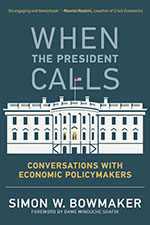 VERDICT: Not for Me, Maybe for You
VERDICT: Not for Me, Maybe for You
When the President Calls: Conversations with Economic Policymakers
By Simon W. Bowmaker (Cambridge, MA: The MIT Press, 2019). 688 pgs. $34.95. Order, http://mitpress.mit.edu.
Reviewed by Dianne Post
I expected When the President Calls: Conversations with Economic Policymakers to be more of a policy book with comparisons among schools of thought and analysis of theories among the different presidential administrations. It isn’t. It is comprised of identically structured interviews with persons who worked in financial positions (Council of Economic Advisors, Office of Management and Budget, Department of the Treasury, and National Economic Council) from the Nixon through the Trump administrations.
The author clearly knows the subject, given that he asked each person about some crisis or main event that occurred during that person’s tenure. Each person was also asked about their relationship with the particular president (some served more than one) and about the president’s grasp of economics and economic theory.
I read the book because my grasp of economics and economic theory is not great and I thought I could learn something. I didn’t. Many of the interviewees said that economics brought rigor in thinking but then argued about the theory, facts, and analysis of whatever they didn’t agree with. Some agreed that if you put two economists in the same room, you get three opinions, and some presidents asked for a one-handed economist so she or he would stop saying “on the other hand.”
There was a wide difference in policies, politics, personalities, and presidents. Some of the comments were surprising in light of historical facts. There were disagreements about deficit and debt, disputes with supply siders and trickle down, and debates about “entitlement” programs and safety nets. Everyone agreed that finance is policy, and some spent a lot of time trashing others, puffing up their own achievements, and touting their own political views. All but one agreed that the level of financial literacy in the United States should be raised.
The author’s goal was to see how personalities shaped policy making and how the political realities and the economic ones battled (spoiler alert – politics won). There were no right answers because the cost-benefit analysis depended on the particular administration’s political persuasion and whose ox was gored. I don’t necessarily agree with the author’s conclusions nor believe he showed how personalities shape policy but how politics does. I do agree that the learning curve is steep and the buck stops with the president, whether the president likes it or not.
Dianne Post, U.W. 1979, practiced family law for 18 years in Arizona, mostly representing battered women and molested children before she switched to international human rights law in 1998.
